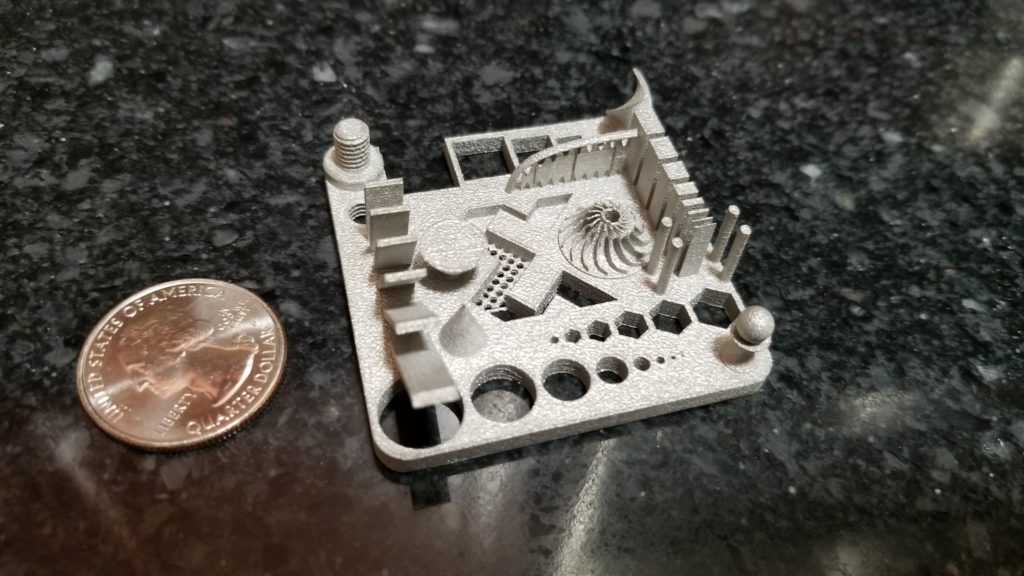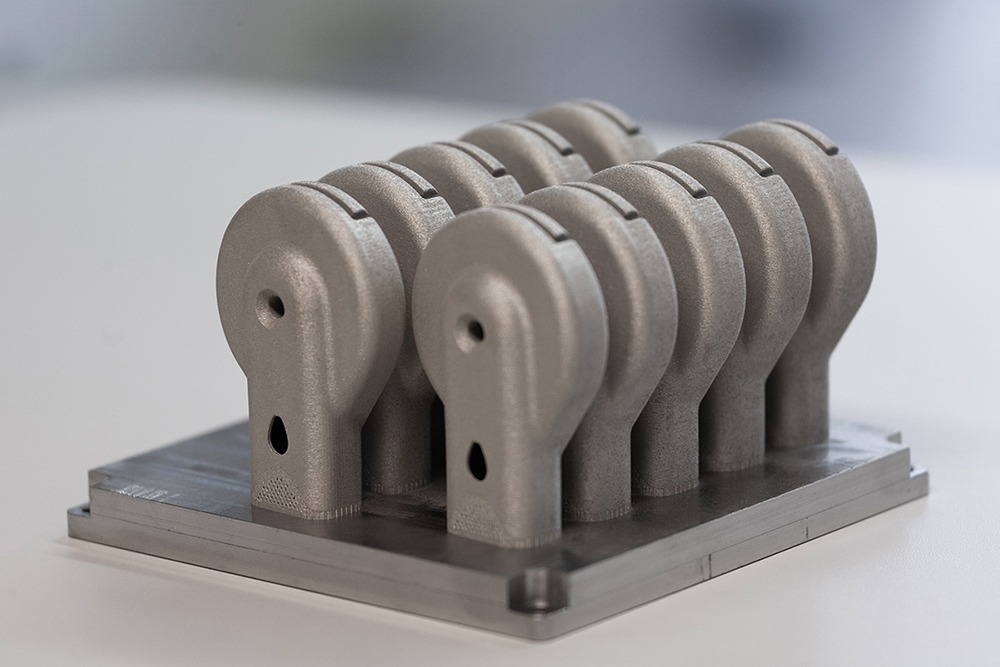
3D printers have quietly been transforming production lines at some of the world’s leading manufacturers. Once considered primarily for prototyping; advancements in materials and productivity have made 3D printers a powerful tool for applications beyond prototyping that range from tooling to end-use parts.
As these 3D Printers move from R&D onto the shop floor the question that keeps coming up is “Will 3D printing ever replace CNC Machining?” The short answer is no because it doesn’t need to.
Both 3D Printing and CNC Machining have their place in manufacturing. The truth is they are friends not adversaries. Simply put, these are two different tools in your toolbox! Both are useful, but do different jobs. The key is to know how to use them for your application.
The main difference between the tools is that 3D printing is an additive process while CNC is a subtractive process. 3D printing starts from nothing and builds a part layer by layer. Whereas CNC begins with a stock of material and removes that material until the desired shape is achieved.
Here are the advantages of each:
3D Printing Advantages:
- Design Freedom – geometries can be achieved that are otherwise not possible with traditional manufacturing methods (i.e. complexity is freer). This includes:
- Part consolidation – assemblies that require multiple parts and fabrication/joining methods can be printed as a single piece.
- Lightweighting – 3D printing allows you to put material only where it is needed. You can easily create voids, honeycomb or lattice structures without creating extra steps or energy to remove them.
- Speed – There is minimal time from 3D file to part in hand. Multiple variations can be done on the fly.
- Less Programming Time – Compared to CNC machining, 3D printing requires much less user interaction to create the machine motion path. In some cases it can be push-button simple but in other cases it may require much more knowledge such as to create optimum support structures for SLA or DMLS.
- Less Waste – You only use the material you need to produce the part. Even with support structures, the material consumed is often much less than subtractive. In fact, with some additive processes the left-over material is reusable.

CNC Machining Advantages:
- Materials – There is a very broad range of materials available for CNC including metals, plastics and wood. Generally, for high volume production 3D printers it is uncommon to have more than a couple or several material options. Even with the limited number sometimes the changeover can be costly and time consuming.
- Tolerance – CNC machining has the ability to machine parts to tight tolerances; frequently 10 to 100 times better than 3D printing.
- Surface Finish- The surface finish of parts from CNC machines is often very good depending on the part geometry, tool geometry, and machining time.
- General Acceptance of the Output: Due to the certification of pre-existing parts and the CNC manufacturing methodology, many industries are more accepting of CNC machined parts.
- Open Architecture – Generally, users of CNC technology purchase their tooling and materials from 3rd party suppliers and enjoy multiple sources for those items; whereas, 3D printer users frequently have to source their supplies from a single source. Most of the time this source being the 3D printer manufacturer. While this is starting to improve, 3D printing has a great deal of catchup to do in this area.
“I think companies need to always be open to change. Not only so that we make quality parts with the machines that we already have, but also looking for ways to improve our capabilities to serve our customers with new ideas and new technology.” Sean Farrell, Dura-Metal
Hybrid (CNC & 3D Printing) Approach Benefits:
- Better Parts: Combining additive and subtractive processes gives you the design freedom in 3D printing with the tight tolerances only achievable with CNC machining.
- Better Shop Floor Utilization- By using 3D printing for design iteration, testing, and production of custom tools and fixtures you free up utilization on CNC machines for profitable, predictable jobs.
- Improved Operational Efficiency: By utilizing your machines and equipment for the jobs they are best suited to perform you can extend the life of your machinery and reduce the cost to maintain your equipment.
- Deepen Customer Relationships- Combining 3D Printing with CNC machining can allow you to produce parts that you’d otherwise turn down. It also enables you to suggest new ways of making components that could be more valuable to your clients. This can strengthen your business relationship while also attracting new customers & new revenue.
“Our goal with adding 3D Printing was to improve our machine shop efficiency, light-weight certain parts, and reduce assemblies as much as possible. 3D Printing helped us do all of that.” Adam Duche, Aerotech Industries
Conclusion:
3D Printing & CNC Machining can indeed work together to serve your customers better. The first step should always be to decide which technology is best for your part. Both processes have their advantages and both complement each other, which can then provide you and your customers with:
- Increased flexibility and independence
- Time and costs savings
- Expanded manufacturing capabilities
- improved internal processes

Please join us at one of our two live one-of-a-kind informational in-person events where we will showcase some of the latest metal 3D printing technologies. If you have any interest in learning more about 3D Printing this is a great opportunity! Attendance is free, but you must register to attend.
The first event will be held at the Cimquest headquarters in Branchburg, NJ on April 28, 2022. Attendees will be able to tour our new Metal 3D Printing showroom, interact with parts, and network with other participants. This is a great way to learn about key industry insights in Metal Additive and see how it can open an entirely new world of applications and jobs. Nate Higgins, Co-founder of FreeFORM will be available to discuss their use of 3D Metal Printing.
For the second event, Cimquest is partnering with ABCorp and hosting the event at their facility in Boston, MA on May 4, 2022. ABCorp designs 3D-printed highly-detailed prototypes and parts and they deliver omnichannel content to elevate the customer experience. They will be explaining how they are using additive technologies to grow their business today and in the future. At this event, you’ll also get to see the Desktop Metal Shop System live, tour ABCorp’s Shop Floor, and interact with parts.
At both events we will be giving away these metal 3D-printed sample parts. Join us for a very informative and enjoyable day and score yourself one of these unique gifts.
About Cimquest:
Cimquest has been a leader in both Additive and Subtractive technologies for over 26 years. Global leadership with many products such as: Mastercam, Desktop Metal and Xact Metal, Cimquest helps to direct companies in their quest for manufacturing excellence. If you are interested in talking to one of our team of experts about selecting or optimizing your additive or subtractive manufacturing technologies, give us a call.
Subscribe to Our Email Newsletter
Stay up-to-date on all the latest news from the 3D printing industry and receive information and offers from third party vendors.
Print Services
Upload your 3D Models and get them printed quickly and efficiently.
You May Also Like
Formlabs Teams Up with DMG MORI in Japan
In late June, Nick Graham, Chief Revenue Officer at Formlabs, announced on LinkedIn that the company had partnered with DMG MORI, one of the world’s leading machine tool companies, to...
Nikon SLM Solutions & ArianeGroup to Collaborate on Large-Scale Metal 3D Printed Components
Just after announcing a collaboration with RocketLab, Nikon SLM Solutions is now announcing another with French space leaders ArianeGroup. The goal of their partnership will be to make metal additive...
Rocket Lab and Nikon SLM Solutions Sign MoU for New Large Metal 3D Printing Systems
Nikon SLM Solutions has signed a Memorandum of Understanding (MoU) with Rocket Lab. The aerospace manufacturing firm wishes to reserve two new “ultra-large format metal additive manufacturing platforms.” This is...
3D Printing News Briefs, June 14, 2025: Awards, CNC Integration, Sneakers, & More
We’re kicking off today’s 3D Printing News Briefs with some exciting news, as the winners of this year’s TCT Awards have been announced! Then it’s on to business, with Shapeways...
































